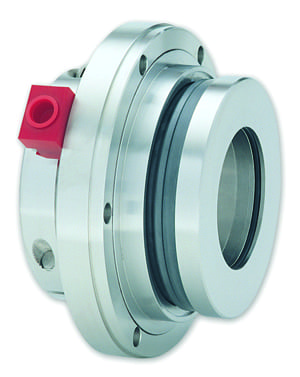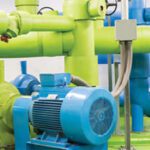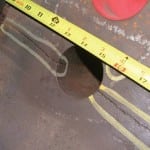A German power plant experienced premature wear and excessive seal corrosion in its boiler feed circuit and flue gas desulfurization slurry pumps. By upgrading the performance of the pump seals and implementing a high-performance seal maintenance, repair, and part stocking program, unplanned pump shutdowns were eliminated and mean time between repairs improved from 20 to 40 months.
As with all rotating equipment, pump seal wear is a constant factor requiring continual monitoring, maintenance, repair, and replacement to keep pumps operating as specified. In coal-fired power plants, mechanical seals are utilized in pumps throughout many processes.
Mechanical seals consist of a stationary primary element that is fixed within the pump housing and a rotating mating element fixed to the shaft. Precisely machined, these two components are pressed together, meeting at a wear face, while the extreme tolerances between the two elements minimize leakage. The seals rely on a certain amount of leakage to lubricate the moving surfaces. The rotating element is supported on an extremely thin lubricating film, typically 0.25 microns in thickness.
These seals are influenced by a number of factors, including temperature, pressure, vibration from pump shaft misalignment, and quality of the pumped fluids. Coal-fired plants have many processes that contain abrasives and solids within the fluids being pumped. These insoluble liquids are hard on mechanical seals because they create added abrasion and erosion of the components. The particles can get into the mechanical seals’ O-rings and springs, causing these components to go rigid and no longer able to move with the shaft movements and pressure deflections.
Mechanical Seal Degeneration at German Coal-Fired Plant
In coal-fired plants, mechanical seals (Figure 1) can be found in the main heat cycle for pumping raw feedwater, boiler feedwater, condensate, and the cooling water that supports the condensate system. They are used in secondary pumps, fire suppression systems, and service and wastewater applications. Mechanical seals are also employed in the movement of limestone slurry for the flue gas desulfurization (FGD) scrubber system.
 |
|
1. This cutaway image shows the internal components of a mechanical seal. Courtesy: John Crane |
At one of Germany’s largest lignite-fired power plants, boiler feed circuit pump seals and FGD slurry pump seals were negatively impacted, experiencing a significant reduction in mean time between repair (MTBR), ultimately resulting in unplanned pump shutdowns. The pumps experienced premature seal wear and excessive seal corrosion as a result of adverse reactions to feedwater treatments, coupled with inadequate maintenance and part stocking issues.
The core of this thermal power generating plant, the boiler feed circuits rely on high-speed, high-performance pumps to keep the water moving through the systems. Each boiler feed circuit has two high-speed, high-performance pumps feeding the boiler, and approximately 100 secondary pumps along the feed circuit. Plant-wide, the boiler circuits have 12 high-performance pumps and approximately 600 secondary pumps. Each of these pumps has mechanical seals and the high-performance boiler pumps have two mechanical seals for each pump.
In high-purity boiler feedwater/combined oxygen treatment processes, with high-speed, heavy-duty pump applications in boiler feed circuits, minute electrical potentials develop, which cause electrostatic corrosion on the mechanical seals. The material of the mechanical seal itself becomes degraded, resulting in a shortened lifespan. This condition is due to chemical reactions from combined oxygen treatment procedures of the feedwater initiated to reduce corrosion in the boiler, resulting in the creation of electrical voltage.
The high-performance boiler feed circuit pumps are integral to the operation of any thermal power generating plant. If just one of these pumps fails, that boiler feed circuit would be running at 50% operation, or could be potentially shut down. Failure of the mechanical seal is the primary cause of pump failure. This is just what occurred at this plant, where boiler feed pump seal integrity was lacking, causing unplanned pump shutdowns.
The plant’s FGD, a set of wet-scrubber technologies used to remove sulfur dioxide (SO 2) from exhaust flue gases of fossil-fuel power plants, uses a wet limestone (calcium sulfite, CaSO 3) slurry through which flue gas containing SO 2 is passed in absorber spray towers.
The German plant has 60 main feed pumps in the FGD circuit—with an additional 250 to 300 secondary pumps—for a total of 310 to 360 pumps involved in plant-wide FGD. The abrasive and corrosive wet limestone slurry put high corrosive demands on both pumps and seals at the plant. FGD feed pump seals at the plant failed due to metal erosion and corrosion issues, resulting in a lack of seal component flexibility. The corrosion came from the calcium sulfite, and the erosion from the fluid velocity in close to the mechanical seals.
Engineering a Solution
John Crane, whose seals were originally installed in the plant’s boiler feedwater pumps, was selected to implement a comprehensive program to isolate the cause of the premature pump seal degradation in both boiler feed circuit pumps and FGD slurry pumps; engineer a mechanical solution to extend longevity for the seals; implement a system to monitor the ongoing condition of the feed water; and establish a structured maintenance, repair, and part stocking regimen for both boiler feed circuit pump and FGD slurry pump seals.
Boiler Feed Circuit Pump Seals. John Crane thoroughly investigated the condition of the boiler feed circuit pump seals, and developed a strategy to mitigate the problem. This included specifying and installing specific components for the boiler feed seals of this plant; implementing an ammonia dosing system, which feeds an ammonia solution around the mechanical seal to increase electrical conductivity of the feed water; and putting into place a control system to monitor the electrical conductivity of the feed water, integrated into the pump programmable logic controllers.
The solution changed the conductivity of the water around the seals and included changing the seal face materials. The result was more reliability and longevity. The project has been underway for some time and has doubled the life of the seals.
The feed pump seals in place are heavy-duty John Crane Type 270F O-ring pusher cartridge seals for boiler feed circuit applications. They are designed for critical high-pressure, high-temperature, and high-shaft speed applications. The face and seat are computer-engineered for optimum distortion control leading to high reliability and long operating life.
These seals can handle temperature limits from –40F to 500F (–40C to 260C); pressure limits up to 1,000 psig (69 barg); and speed limits up to 4,000 feet per second (60 meters per second). Advanced computer-designed faces maintain optimum performance under all temperatures and pressures.
 |
|
2. Available as a single or double seal, the Type 5860 mechanical seal is designed to operate in the harshest abrasive slurry environments. Courtesy: John Crane |
FGD Slurry Pump Seals. Together with the local pump service companies of the original equipment manufacturers that supplied the FGD slurry pumps, John Crane conducted considerable testing, then engineered a mechanical seal solution. The corrosion and erosion problem, which concerned the 60 main FGD feed pumps, was solved by installing heavy-duty John Crane Type 5860 cartridge slurry seals (Figure 2). These seals are specially designed to operate in the harshest abrasive slurry environments, including exposure to process fluids such as limestone. These seals can manage slurries with solids content up to 50% by weight, without the need for water flush support.
The seals can handle temperature limits up to 180F (80C); pressure limits up to 360 psig (25 barg); and speed limits up to 65 feet per second (20 meters per second). The seal face provides maximum stability and minimum heat generation under adverse conditions, optimizing performance with maximum seal face life and lubrication.
The solution mitigated both the erosion and corrosion problems. The net result was a measurable extension of the running life of the FGD slurry pump seals.
Managing Ongoing Pump Seal Reliability
The plant required a reliable way to manage and repair seals to improve MTBR. Stocking problems and tracking difficulties created confusion and frustration among operations technicians, as well as part procurement specialists. It was insufficient management of these areas that premeditated the premature degradation of the plant’s pump seals and resultant pump failures.
A critical component necessary to restoring and maintaining the integrity of the plant’s pump seals was the establishment of a program for ongoing seal inspection, maintenance, repair, and part stock management. And it needed a 24×7 stocking program that would integrate with its existing enterprise resource planning (ERP) system. To facilitate organization and structure in this area, John Crane implemented its Performance Plus Reliability Program, called Interface, for management of the plant’s mechanical seals.
Program development for reliability support began with a comprehensive feasibility study to establish the full scope of the plant’s needs. It measured equipment performance, calculated total cost of ownership, and identified opportunities for improvement and cost savings. Once the data was collected, John Crane used Interface reliability management software to benchmark asset performance against industry averages and to perform a cost/benefit analysis.
The program initially inspected the existing seal installments and stocking procedures, then it made recommendations to bring order to existing repair and stocking systems to deliver high pump reliability. The stock standardization program ensures that correct quotes and orders ultimately find their way to the right equipment. It is linked to the plant’s ERP system, streamlining seal repair, stocking, and tracking.
All failures from existing seals are now immediately sent to a nearby John Crane service center for 24×7 repair. Dedicated spare parts are available 24×7 as part of the product/stock standardization program. The mechanical seal service delivers new John Crane seals and seal components to the plant, eliminating delays, and inefficient and faulty repairs. Additionally, training was provided to onsite field engineers and operations personnel to reduce the risk of unplanned downtime and recurring issues in the future.
The Performance Plus Reliability Program ensures high pump reliability and reduced maintenance costs for the plant’s rotating pump mechanical seals.
Ultimately, unplanned pump shutdowns at the lignite-fired power plant in Germany were eliminated. MTBR, a key driver for the industry, was increased 100%—from 20 months to more than 40 months—because of improved seal maintenance, repair, and stocking initiatives, including replacing existing seals with new John Crane components. ■
—Wolfram Enders is a senior application engineer with John Crane.










